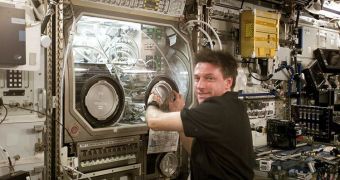According to the conclusions of a new scientific study, it would appear that astronauts who spend prolonged periods of time on the International Space Station (ISS) may develop eyesight problems, including blurry vision. The discovery is of great concern to experts planning long space missions.
A manned mission to the Red Planet, for example, would last at least 18 months. This is about three times longer than a standard, long-duration stay on the ISS. Such a stay is apparently enough to cause lasting eye problems, so wouldn't a mission to Mars be even more dangerous?
Experts with the Alaska Native Medical Center, in Anchorage, determined that lasting eye problems can still be discerned in seven astronauts that have long since returned to Earth. The team believes that this should be taken into account by mission planners putting together longer missions.
All test participants – average age 50 – reported experiencing a number of vision-related problems while still aboard the ISS. At this point, the reasons why microgravity damages vision are not yet fully understood, but scientists do have some hypotheses, Space reports.
All subjects reported that the issues they experienced started manifesting themselves around 6 weeks after they arrived on the station. For the most part, their vision cleared as they reached Earth again, but the process took a long time to complete.
Scientists were able to weed out spacecraft launch and atmospheric reentry as possible causes for the deteriorated vision, since the effects only occurred in astronauts who spent 6+ months in space.
“In astronauts over age 40, like non-astronauts of the same age, the eye's lens may have lost some of its ability to change focus,” ANMC ophthalmologists and study team member Thomas Mader explains.
He says that scientists were able to identify a number of changes in the eyes of astronauts. These included a flattening of the back of their eyes, as well as significant modifications in their ocular nerves, tissues and fluids.
Full details of the investigation were published in the October issue of the American Academy of Ophthalmology (AAO) medical journal Ophthalmology. One possible explanation the team provides is that all astronauts experience an increase in intracranial pressure.
Increased pressure in the head usually triggers chronic headaches, double vision or ringing in the ears, but the astronauts reported experiencing no such symptoms. This meant that perhaps the issue was located elsewhere.
Scientists now believe that abnormal flow of spinal fluid around the eye's optic nerve may be partially to blame. The blood flow in tissues around the retina may have also taken on new patterns.

 14 DAY TRIAL //
14 DAY TRIAL //